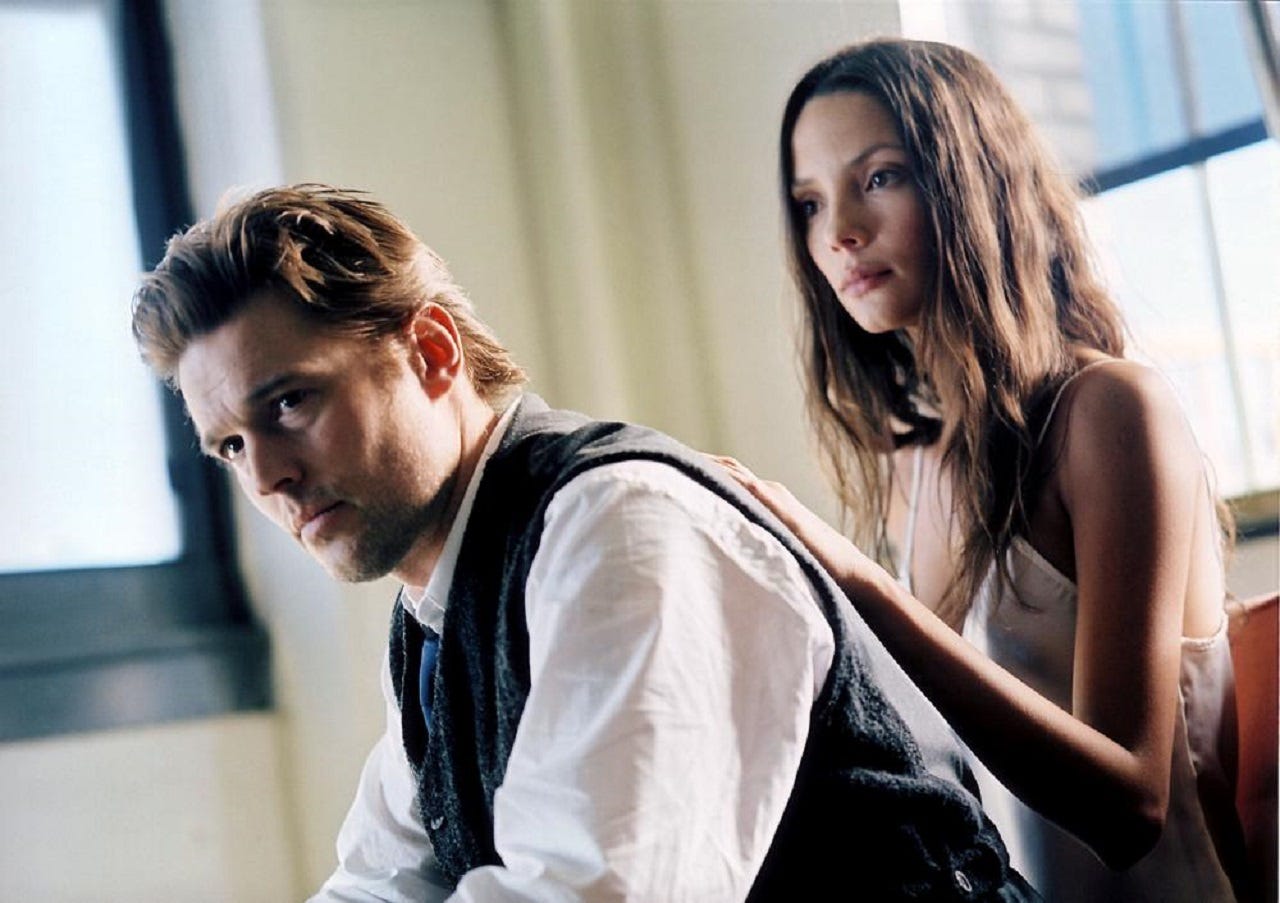Hal Hartley And The Girl From Monday
While Hartley's work streams on Criterion, another look back
Like many American independent filmmakers, writer-director Hal Hartley started experimenting with digital video by the turn of the century, with The Book Of Life. With his near-complete filmography streaming on the Criterion Channel, here’s an interview from Sundance 2005 with Hartley about The Girl From Monday and its “aleatory” origins. The Criterion Channel streaming link is here. The opening credits of the film are here.
HAL HARTLEY CALLS HIS NEWEST MOVIE, The Girl from Monday, “fake sci-fi.”
What it is, genuinely, is an anomaly. Stark yet brightly colored, up in its characters’ faces, yet almost always seen from tilted angles, filled with gestures yet also reliant on mordant, explicit narration, The Girl from Monday finds a marketing exec meeting a beautiful woman from another constellation after “the great revolution.” Bill Sage, weary-eyed and skeptical, with gelled hair ever in need of wrangling, is obsessed with sex and its market(ing) value. While Hartley is slated to shoot Fay Grim, a comic narrative sequel this year to his dour intimate epic 1998 Henry Fool, The Girl from Monday most resembles his 1999 The Book of Life, a shot-on-video, $350,000 production that embraced video as a visual medium as well as a shambling, episodic approach to storytelling.
For this emphatic essay, made on the same scale, Hartley and his partners have focused on distributing the movie on DVD directly to consumers, without conventional theatrical or festival release. “We’re using the paradigm of rock bands,” the lanky, laconic forty-five-year-old director of ten features and many shorter works says, “They go on tour to promote the new album. I think I’ll just make more money selling DVDs than going through the whole theatrical release [process].” Is there a living in that? “If getting rich was a priority, I would not be making movies. That’s definite. There’s gotta be easier ways to get rich than making movies, right?”
“When [cinematographer] Sarah [Cawley-Cabiya] and I first started discussing in it 1999, it was intended to be a 35mm, million dollar film shot in 24 days,” he says. “’Book of Life’ was the real inspiration. It jumped off from there, back in that century.” He laughs. “Our esthetic then, we called it ‘exquisite miniatures.’ We were going to make it look beautiful, but the pictures were going to be small. I think [this script] lends itself to DV. [Digital video] likes small.”
Small is also the word for the cottage industry of Hartley and his partners’ new company, which has released one non-Hartley feature, but focused primarily on his work. “The Possible Films Collection started kind of casually with this CD compilation of music from my earlier films. We were responding to hits on the website, people asking about he music from the films, so I decided to produce that CD and sell it directly from my website. Again, [we were] inspired by musicians who were doing this kind of thing. That was a really easy success, so the next year, I started doing the collection of short video and films from the past ten years.
“We have a real good system that doesn’t require a lot of overhead or a lot of people. The database is quite large and growing. [My partner] Steve Hamilton, my editor and co-producer, [suggested we think] of making The Girl from Monday in a much smaller way, that has more in common with video work I do that winds up on DVD. We were a little ambivalent. We didn't know anyone else who was doing this, and it’s hard to break habits. It’s hard to be hard-line about it, ‘We’re going to make a movie and you can only buy it from our website.”
“Direct-to-video” is usually a slur, a phrase with a stigma. “Yeah. Yeah,” Hartley says quickly. “A stigma invented by the studios and the distributors which is completely fake. The other day, at a panel discussion, just before we were going on, a distributor said, ‘But if you do that, the newspapers don’t review movies unless they have a theatrical release.’ I was, ‘Fuck ‘em, they will once everyone starts releasing work on DVDs.’”
Aside from being composed in tight frames in order to suggest a militarized urban future with little dressing and lowered production cost, the movie was shot at a 12-frame-per-second shutter speed, offering a “painterly” streaking and strobing when there’s motion in the fame. Hartley talks about discovering rather than imposing an esthetic, taking the freedom to fool around rather than being unnecessarily rigid. “I’ve always been like that. I remember when I was a kid, my sister Loretta could never figure out parallax view with a little family camera. She’d take a picture of you, it’d [always be off]. I found some of the most beautiful compositions. They’d always be throwing them away, but I had hundreds of Loretta’s snapshots which became the basis of a lot of paintings and drawings I was doing as a teenager. I couldn’t say it at the time, but it had something to do with this word, ‘aleatory,’ that I found. The welcoming of chance into the filmmaking process. It’s a good word.”





